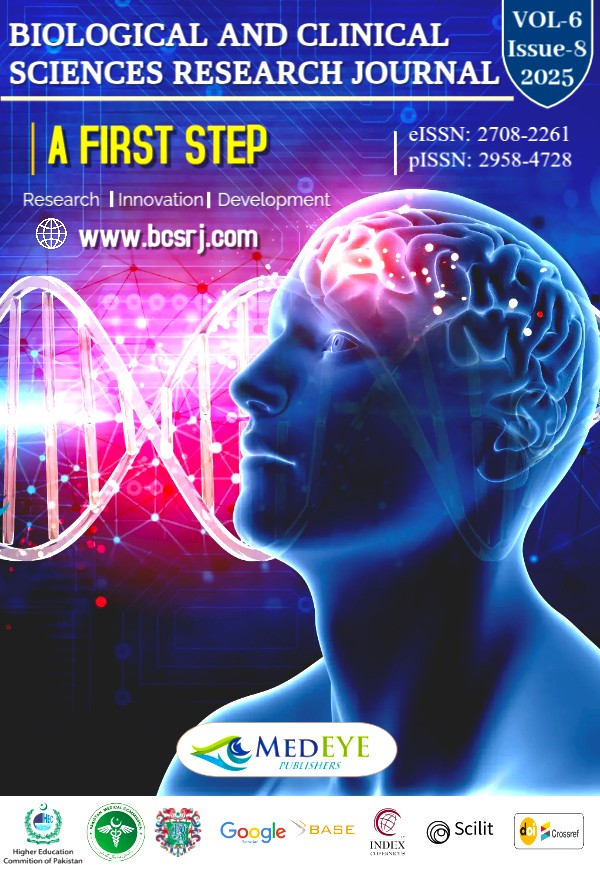Frequency of Primary Infertility with PCOS among Women Aged 25 to 30 Years in Tertiary Care Hospitals Quetta
DOI:
https://doi.org/10.54112/bcsrj.v6i8.1950Keywords:
Primary infertility, polycystic ovarian syndrome, Reproductive health, Quetta, Women aged 25–30 yearsAbstract
A significant worldwide health issue, infertility has detrimental psychological and societal effects. With 3.5% of cases being primary infertility, Pakistan has one of the highest rates of infertility in South Asia. Anovulatory infertility is primarily caused by polycystic ovarian syndrome (PCOS), the most common endocrine condition affecting women of reproductive age. Nevertheless, there is still a lack of information about infertility in Balochistan linked to PCOS. Objective: to ascertain the prevalence of PCOS-related primary infertility in women between the ages of 25 and 30 who visit Quetta's tertiary care facilities. Methods: This cross-sectional descriptive study was carried out in Quetta's tertiary care hospitals' obstetrics and gynecology departments. Through non-probability convenience sampling, 200 married women between the ages of 25 and 30 who met the Rotterdam criteria for PCOS and main infertility were included. A standardized, pre-tested questionnaire that covered socio demographic information, menstrual and reproductive history, PCOS clinical symptoms, ultrasound findings, and psychosocial impact was used to gather data. SPSS version 26 was used for data analysis. While chi-square and independent t-tests were used to evaluate relationships, descriptive statistics were computed. Results: On ultrasonography, polycystic ovaries were seen in nearly half of the individuals (49.5%), and irregular menstruation was very common (oligomenorrhea in 28% and amenorrhea in 25%). Of those with clinical signs, 46% had acne, and 42.5% had a family history of PCOS or infertility. 48% cited marital or family strain, and nearly half (47.5%) reported a lower quality of life. There was no statistically significant correlation (p = 0.209) between the length of infertility and BMI. Conclusion: According to the study, PCOS significantly contributes to primary infertility in Quetta among women between the ages of 25 and 30. The burden of PCOS-related reproductive difficulties in this population is highlighted by the high prevalence of sonographic and clinical characteristics. Improving fertility and quality of life requires early diagnosis, lifestyle changes, and effective management techniques.
Downloads
References
Elasam A., Ahmed M., Ahmed A., Sharif M., Abusham A., Hassan B.et al.. The prevalence and phenotypic manifestations of polycystic ovary syndrome (pcos) among infertile sudanese women: a cross-sectional study. BMC Women S Health 2022;22(1). https://doi.org/10.1186/s12905-022-01762-6
Lê M., Nguyễn V., Truong Q., Le D., Lê V., & Cao N.. Metabolic syndrome and insulin resistance syndrome among infertile women with polycystic ovary syndrome: a cross-sectional study from central vietnam. Endocrinology and Metabolism 2018;33(4):447. https://doi.org/10.3803/enm.2018.33.4.447
Keeratibharat P., Sophonsritsuk A., Saipanish R., Wattanakrai P., Anantaburana M., & Tantanavipas S.. Prevalence of depression and anxiety in women with polycystic ovary syndrome (pcos) and associated factors in a quaternary hospital in thailand: a cross-sectional study. BMC Psychiatry 2024;24(1). https://doi.org/10.1186/s12888-024-06154-8
Sam S. and Ehrmann D.. Pathogenesis and consequences of disordered sleep in pcos. Clinical Medicine Insights Reproductive Health 2019;13. https://doi.org/10.1177/1179558119871269
Lavor C., Júnior A., & Medeiros F.. Polycystic ovary syndrome and metabolic syndrome: clinical and laboratory findings and non-alcoholic fatty liver disease assessed by elastography. Revista Brasileira De Ginecologia E Obstetrícia / Rbgo Gynecology and Obstetrics 2022;44(03):287-294. https://doi.org/10.1055/s-0041-1741032
Cooney L. and Dokras A.. Beyond fertility: polycystic ovary syndrome and long-term health. Fertility and Sterility 2018;110(5):794-809. https://doi.org/10.1016/j.fertnstert.2018.08.021
Maldonado S., Grab J., Wang C., Huddleston H., Cedars M., & Sarkar M.. Polycystic ovary syndrome is associated with nonalcoholic steatohepatitis in women of reproductive age. Hepatology Communications 2022;6(10):2634-2639. https://doi.org/10.1002/hep4.2039
Aslam M., Qurat-ul-ain A., & Fatima R.. Psychological effect of polycystic ovary syndrome on health related quality of life among young women: moderating role of proactive coping strategies. Review of Applied Management and Social Sciences 2023;6(2):447-458. https://doi.org/10.47067/ramss.v6i2.340
Omar H.. Prevalence, clinical patterns, and associated risk factors of polycystic ovarian syndrome among women seeking fertility treatment at kilimanjaro christian medical centre hospital, northern tanzania. International Journal of Gynecology & Obstetrics 2025. https://doi.org/10.1002/ijgo.70131
Abdelbagi Z., Badi S., Ahmed M., Ahmed M., & Elkheir H.. Knowledge, prevalence and practice of polycystic ovary syndrome among sudanese women in khartoum state, sudan: the need for health education. Sudan Journal of Medical Sciences 2022;17(2):204-217. https://doi.org/10.18502/sjms.v17i2.11455
Nwakobe C. and Ilouno I.. Polycystic ovary syndrome and infertility in niger state, nigeria: challenges, outcomes, and early intervention. Journal of Prevention Diagnosis and Management of Human Diseases 2024(46):1-9. https://doi.org/10.55529/jpdmhd.46.1.9
Khan S., Zubair M., Rehman A., Zahid I., Gulali S., Yousafzai S.et al.. Sonographic association between hepatic steatosis disease and polycystic ovarian syndrome in swabi women. JHRR 2024;4(1):1787-1790. https://doi.org/10.61919/jhrr.v4i1.718
Gainder S., Sachdeva G., Suri V., Sachdeva N., & Chopra S.. Obese and non-obese polycystic ovarian syndrome: comparison of clinical, metabolic, hormonal parameters, and their differential response to clomiphene. Indian Journal of Endocrinology and Metabolism 2019;23(2):257. https://doi.org/10.4103/ijem.ijem_637_18
Niksima S., Odel N., Khaki S., Gheshlagh R., Fallahi A., & Kurdi A.. Prevalence of metabolic syndrome among iranian women with polycystic ovary syndrome: a systematic review and meta-analysis. Diabetes & Metabolic Syndrome Clinical Research & Reviews 2019;13(3):1911-1915. https://doi.org/10.1016/j.dsx.2019.03.026
Nisekhkhuu A., Olzvoi A., Radnaabazar N., Khasag A., Davaatseren M., & Baldandorj B.. Metabolic syndrome in women who have polycystic ovary syndrome related infertility. Central Asian Journal of Medical Sciences 2021;7(3):259-268. https://doi.org/10.24079/cajms.2021.09.011
Park Y., Shin H., Jeon S., Cho I., & Kim Y.. Menstrual cycle patterns and the prevalence of premenstrual syndrome and polycystic ovary syndrome in korean young adult women. Healthcare 2021;9(1):56. https://doi.org/10.3390/healthcare9010056
Khudhair M.. Evaluation of some hematological and biochemical parameters for women with polycystic ovary syndrome in wasit governorate. Wasit Journal of Pure Sciences 2023;2(4):185-193. https://doi.org/10.31185/wjps.259
Masood Z., Suhail M., Anwar K., Hassan A., Tariq K., Zafar H.et al.. Knowledge and perception of polycystic ovarian syndrome among medical students. 2024. https://doi.org/10.21203/rs.3.rs-5041326/v1
Cho I., Chang Y., Kang J., Kim Y., Sung E., Shin H.et al.. Long or irregular menstrual cycles and risk of prevalent and incident nonalcoholic fatty liver disease. The Journal of Clinical Endocrinology & Metabolism 2022;107(6):e2309-e2317. https://doi.org/10.1210/clinem/dgac068
Ganie M., Vasudevan V., Wani I., Baba M., Arif T., & Rashid A.. Epidemiology, pathogenesis, genetics & management of polycystic ovary syndrome in india. The Indian Journal of Medical Research 2019;150(4):333-344. https://doi.org/10.4103/ijmr.ijmr_1937_17
Park Y., Shin H., Jeon S., Cho I., & Kim Y.. Menstrual cycle patterns and the prevalence of premenstrual syndrome and polycystic ovary syndrome in korean young adult women. Healthcare 2021;9(1):56. https://doi.org/10.3390/healthcare9010056
Ramanan E., Ravi S., Anbu K., & Michael M.. Efficacy and safety of tracnil™ administration in patients with dermatological manifestations of pcos: an open-label single-arm study. Dermatology Research and Practice 2020;2020:1-10. https://doi.org/10.1155/2020/7019126
Nillni Y., Wesselink A., Hatch E., Mikkelsen E., Gradus J., Rothman K.et al.. Mental health, psychotropic medication use, and menstrual cycle characteristics. Clinical Epidemiology 2018;Volume 10:1073-1082. https://doi.org/10.2147/clep.s152131
Makhija N., Tayade S., Toshniwal S., & Tilva H.. Clinico-metabolic profile in lean versus obese polycystic ovarian syndrome women. Cureus 2023. https://doi.org/10.7759/cureus.37809
Basnet P., Chhetry M., Shah D., Basnet T., Sitaula S., & Dahal M.. Analysis of the phenotypic variants of polycystic ovarian syndrome in women of reproductive age group. Nepal Journal of Obstetrics and Gynaecology 2022;17(2):64-70. https://doi.org/10.3126/njog.v17i2.52379
Wang Z., Jukic A., Baird D., Wilcox A., Li H., Curry C.et al.. Irregular cycles, ovulatory disorders, and cardiometabolic conditions in a us-based digital cohort. Jama Network Open 2024;7(5):e249657. https://doi.org/10.1001/jamanetworkopen.2024.9657
Downloads
Published
How to Cite
Issue
Section
License
Copyright (c) 2025 Farhat Zahoor, Saima Azam, Zahida Haroon, Safia Mengal, Gulnar Ghilzai

This work is licensed under a Creative Commons Attribution-NonCommercial 4.0 International License.








